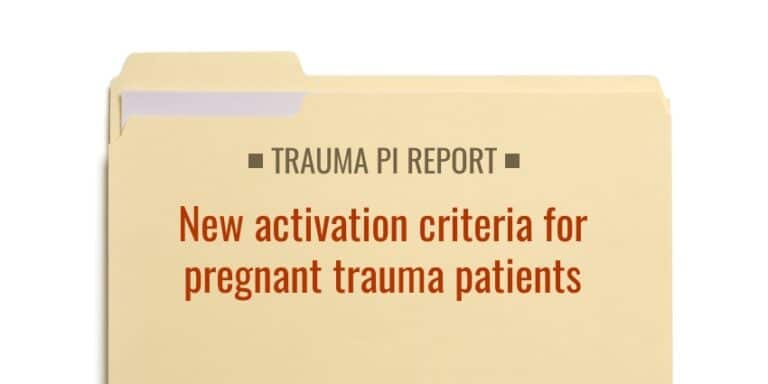When it comes to impactful trauma cases in the Emergency Department, obstetrics cases are often the ones that stick with us the most. Whether the outcome is good or bad, we remember OB cases for a long time. And we always want to learn from the ones with non-optimal outcomes.
My colleagues and I at Advocate Good Samaritan Hospital, a Level I trauma center in Downers Grove, Illinois, experienced a case like this in 2021.
As an obstetric case, it spotlighted a clear opportunity for improvement in a vulnerable patient population. Eventually, it led us to make an important change in our trauma criteria and build closer collaboration with our colleagues in Labor & Delivery.
Minor trauma, unexpected fetal distress
A female, 35 weeks pregnant, presented at the ED following a minor motor vehicle collision. According to EMS, there was minimal damage to the car and the patient was ambulatory at the scene in no distress. Her only complaint was knee pain.

The patient was evaluated within 10 minutes of arrival by the ED physician, an ED physician assistant and an ED registered nurse. All vitals and fetal heart tones (FHTs) were within normal range. An X-ray was performed on the patient’s knee. Bedside ultrasound noted an active fetus and, again, strong FHTs that were within range. The patient was placed in a knee immobilizer and discharged to OB for fetal monitoring within 90 minutes of ED arrival.
However, upon placement of the external fetal heart monitor in the OB unit, it was immediately noted that the fetus was in distress. The patient underwent an emergent C-section and was later found to have had a placental abruption.
This event quickly prompted our healthcare team to look at the case.
Two key process changes
We knew we needed to be able to identify this non-symptomatic, potentially deadly injury sooner. To make this happen, we needed to ensure two things — (1) the mom is evaluated immediately and (2) the fetus is evaluated immediately as well.
Before this event, our trauma activation criteria did not include anything specific to the pregnant patient. In the case described above, mom was evaluated within 10 minutes of arrival. However, if we had been busy, it might have been longer. Since this patient was hemodynamically stable, her only complaint was knee pain and there were no other indicators that met trauma activation criteria, her evaluation could easily have been delayed.
Based on a literature search, we concluded that it does not take significant traumatic impact to cause harm to the fetus, even when the mom is completely stable and has minimal complaints. We realized that we needed to make an OB-centered addition to our trauma criteria.
Our next step was to gain approval from the state to update our Level 2 trauma criteria with the following:
resulting in potential fetus injury (i.e., fall, MVC, assault, etc.).
This addition ensures that an ATLS-verified ED physician will do an initial trauma exam on a stable, low-mechanism, minimal-complaint pregnant trauma patient within 10 minutes of arrival.
That brings us to the second item we needed to address immediately. The only way to fully evaluate a fetus is by external fetal monitoring, which the ED does not do. So in collaboration with our OB healthcare team, we implemented the following process:
This ensures that fetal monitoring will begin as soon as possible in the ED while continued workup on the mother is being performed. If there is an issue or complication with either mom or fetus, then the trauma surgeon and obstetric physician will take over care of the patients.
Better care for pregnant trauma patients
These changes were introduced in November 2021. During the first few months, we focused on hardwiring the new trauma criteria, workflows and ED-OB communication processes into our organization. In addition, our hospital’s Collaborative Process Improvement Team monitored the changes and addressed issues as needed.
With these simple changes in place, the ED has positioned itself to quickly identify any life-threatening situations to both mom and fetus. As of March 2024, we have activated approximately 35 Level 2 traumas based on the updated criteria. Here is one recent case for which we are confident the new criteria and process prevented a bad outcome.
The ED was notified of an incoming 35-year-old female who was 36 weeks pregnant. She was the driver in a single-vehicle accident, with mild to moderate damage to the front passenger side. She was alert and oriented, and her vital signs were borderline (HR 104 and BP 106/57).
The patient reported that she began to feel unwell while driving and blacked out before she hit the median. She denied any pain, including abdominal or back pain, but just felt a little “out of it.” The patient also stated that she possibly had contractions that morning.
Upon EMS report, our ED team activated a Level 2 trauma and notified OB. The timeline is as follows:
- 1254: Trauma alert Level 2 activated, and OB contacted
- 1306: Patient arrived in ED with modified trauma team ready
- 1307: Trauma assessment performed by the ED physician
- 1308: OB RN arrived
- 1315: Fetal heart monitor applied, and monitoring began
- 1318: Fetal distress noted, and patient quickly transferred to OB on ED cart
This patient went for an immediate C-section and was found to have a placental abruption. She was further worked up by the trauma surgeon and admitted to the ICU for close observation. The baby was admitted to the NICU. The mother was discharged 2 days later. At 6 weeks, both mom and baby were home and doing well.
This case showed how a no-cost, patient-centered process change can positively impact patient care. In addition, this process improvement initiative has helped our ED and OB teams developed a stronger working relationship.
Only one case
The primary goal of every trauma center is to provide the best care possible and ensure optimal outcomes for each patient. Most of the time patient care is provided without incident according to standard protocols. But it only takes one case to change that.
When a routine case ends in a non-optimal outcome, the next step is to dissect the case to determine whether anything can be changed in the current process. When we respond to these cases thoughtfully, we can make process changes that prevent a poor outcome in the future.
Regina Rogoz, BSN, RN, TCRN, TNCC, TNS is trauma program coordinator at Advocate Good Samaritan Hospital, a state-designated Level I trauma center in Downers Grove, Illinois.


1 Comment
Thank you but her scan was done which said no distress ,yes e fast in pregnant lady need to modified
May bec
After E-FAST
We can do second scan
OB.. Fast
We r not trained in onest ultrasound but placenta evaluation should be taught